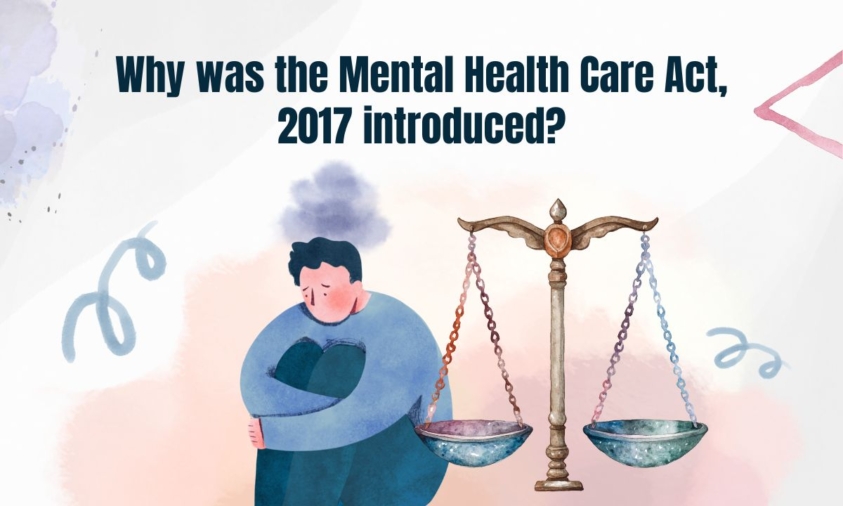Why was the Mental Health Care Act, 2017 introduced?
BACKGROUND: The Mental Health Care Act, 2017 is a landmark legislation enacted to provide comprehensive mental health care and services while safeguarding the rights of individuals with mental illness. It replaced the Mental Health Act, 1987, aligning India’s mental health laws with international human rights standards, particularly the United Nations Convention on the Rights of Persons with Disabilities (UNCRPD), 2006, which India ratified in October 2007. The CRPD is an international convention. A convention is a form of international law which is binding on countries which choose to be governed by the law. The CRPD was adopted by countries (member states) of the United Nations in 2006. It protects and promotes the human rights of all persons with disabilities including those who have mental illness (psychosocial disabilities), It lists down all the rights of persons with disabilities and the manner in which person with disabilities should be treated. i
NEED FOR BILL: The need for amendments to the Mental Health Act, 1987 was felt by the fact that the related law, i.e., the Persons with Disabilities (Equal Opportunities, Protection of Rights and Full Participation) Act, 1995, was also in the process of amendment. The Mental Health Act, 1987 could not protect the rights of persons with mental illness and promote their access to mental health care in the country. In the light of the above it was proposed to repeal the Mental Health Act (MHA), 1987 and bring in new legislation. Over the years, the MHA, 1987 has been criticized by many stakeholders including persons with mental illness, families and caregivers, rights and disability activists, user-survivors of psychiatric care and a segment of the professional psychiatric community.ii
ERWADI TRAGEDY, 2001: The Erwadi fire incident was an incident that occurred on 6 August 2001, when 28 inmates of a faith-based mental asylum died in the fire. All these inmates were bound by chains at the Moideen Badusha Mental Home in Erwadi village in Tamil Nadu, India. Erwadi, known for the dargah of Quthbus Sultan Syed Ibrahim Shaheed Valiyullah, a Moroccan saint who came to India to propagate Islam, became a significant center for those seeking cures for mental health disorders. Many believed that holy water from the dargah and oil from the lamp burning there possessed healing powers. The treatment methods included frequent beatings, caning, and physical restraint, with patients being tied to trees during the day and to beds with iron chains at night. They were expected to receive a divine command in their dreams to return home, which could take months or even years.iii
The study was conducted by NHRC after Erwadi Tragedy, 2001 which provided an in-depth examination of the harsh treatment faced by individuals in mental homes, highlighting cases of people being chained, beaten, and stripped of their dignity. A key issue explored in the report was the distinction between voluntary and involuntary admission of individuals with mental illnesses. The fundamental assumption was that a person with a mental illness should be presumed to have the capacity to make decisions about their own treatment, unless there were exceptional circumstances proving otherwise. In cases where the individual was deemed incapable of making a decision, a quasi-judicial process (a legal mechanism involving impartial decision-makers, such as a mental health board or a magistrate) would be required to determine their admission and treatment, ensuring that their rights were protected.iv
FIGURATIVE ANALYSIS: The shortage of mental health professionals, including psychiatrists (only 4,000 in the country), psychiatric social workers, and nurses, highlighted the urgent need for systemic reforms. While postgraduate psychiatry education and training programs under the National and District Mental Health Programs were expanding, the gap remained significant compared to Western countries. The lack of adequate facilities, trained professionals, and regulatory oversight in mental healthcare emphasized the necessity of the Mental Healthcare Act, 2017, ensuring better access, regulation, and protection of patient rights, including safe administration of treatments like Electroconvulsive Therapy (ECT).v
CONCLUSION: The Erwadi Tragedy along with India’s ratification of the United Nations Convention on the Rights of Persons with Disabilities (UNCRPD), 2006 forms the reasons for the introduction of the 2017 Act. Furthermore, developments in the PwD Act and an increase in postgraduate psychiatry education and training programs also form a basis for its introduction.
PS: There is no reason for the introduction of the 2017 Act with an angle to Section 309 of IPC. However, ‘mental illness’ is mentioned under the definition of ‘person with disability’.vi Moreover, the Appropriate government is required to provide a Reservation of 1% for “autism, intellectual disability, specific learning disability, and mental illness”. vii
Authored by Tanvi Ojha, Legal Intern, The Legal Swan


 Cart is empty
Cart is empty 
